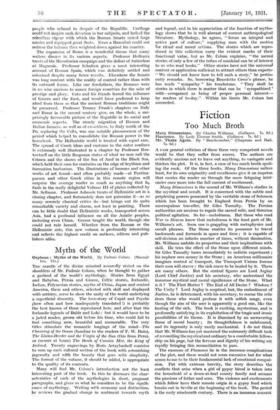Myths of the World .
Orpheus : Myths of the World. By Padraic Colum. (Macmil-
lan. 2124 - Tax _mantle of the divine minstrel assuredly rested on the shoulders of Mr. Padraic Colum, when he thought to gather a garland of the world's mythology. Stories from Egypt and Babylon, Persia and Greece, Celtic stories, Icelandic, Indian, Polynesian stories, myths of China, Japan and central America, these and others, selected with skill and displayed with artistry, serve to show the unity of the world underlying a superficial diversity. The love-story of Cupid and Psyche (how often and how inadequately translated !) is probably the best known of those reproduced here, and after that the Icelandic legends of Baldr and Loki : but it would have to be a jaded reader, grown old before his time, who could fail to find something new, beautiful and memorable. The very titles stimulate the romantic longings of the mind—The Churning of the Ocean (familiar to the readers of F. W. Bain), The Llama-Herder and the Virgin of the Sun (this from. Peru), or (nearer at honle) The Death of Conaire M6r, the King of Zrcland. Twenty engravings by Boris Artzybasheff• contrive to sum up each cultural section of the book with astonishing ingenuity and with the beauty that- goes with simplicity. The format of the volume, it should be added, is appropriate to the quality of its contents.
Many will find Mr. Colum's introduction not the least interesting part of the book. In this he discusses the char- acteristics of each of the mythologies in short, pregnant paragraphs, and gives us what he considers to be the signifi- cance of mythology. -Writing with economy and distinction, he reviews the gradual change in sentiment towards myth
and legend, and in his appreciation of the function of mytho- logy shows that he is well abreast of current anthropological literature. Mythology, he agrees, " forms an integral and active part of culture," supplying man with the motive for ritual and moral actions. The stories which- are repro- duced in this collection carry the evident marks of their functional value, but as Mr. Colum explains, " the sacred stories of only a few of the tribes of mankind can be of interest to us who read books." Other stories have not the universal content or application sufficient to attract others than experts. " We should not know how to tell such a story," he pertin- ently remarks. So, borrowing Benedetto Croce's phrase, he has made " sympathy " his touchstone. " They shall be stories in which there is matter that can be ` sympathized with—recognized as being of proper personal interest— by readers of to-day." Within his limits Mr. Colum has succeeded.


































 Previous page
Previous page